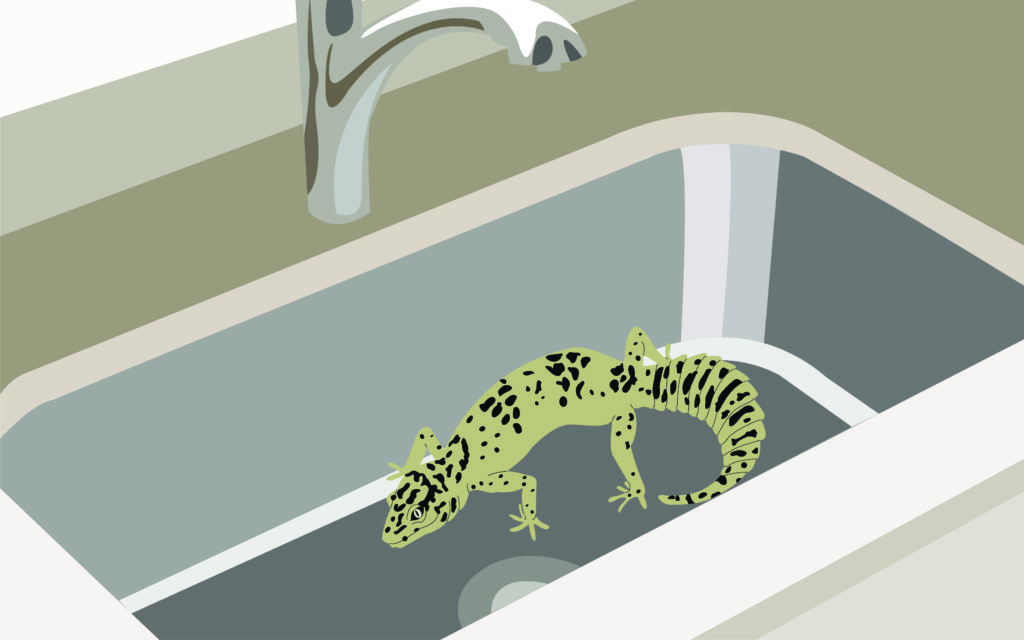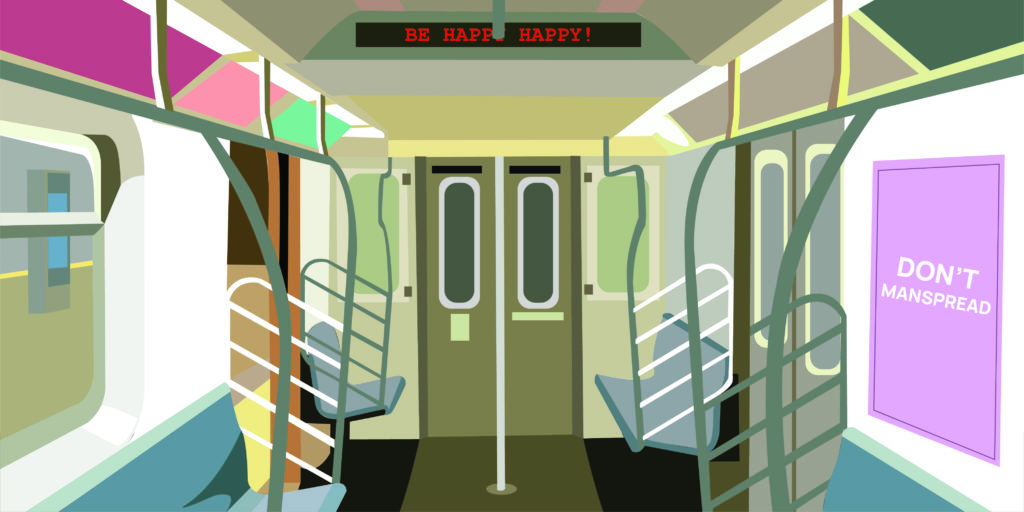At every stop, the prerecorded reminder exhorts riders in the pristine Singapore subway car to put on a cheerful countenance as they exit. The words seem to be nothing more than white noise to the Singaporeans sitting around me, talking with friends, looking at phones, reading a book; for me, though, they’re a comforting reminder to take a moment to appreciate my new life as an expat. I fumble with my phone as I struggle to use Google Maps to calibrate my subterranean progress with the streets above. Cell service is fleeting in the subway, and the exercise of trying to orient me from underground seems futile. But the words make me smile, even as I make a mental note to start traveling above ground more. It’s the only way I’m going to get my bearings on this island.
It’s been four weeks since my husband and I moved to Singapore. Before that, we lived in New Jersey for 24 years. The distance between “there” and “here” is vast, no matter how you measure it — and there are so many ways to do that. Over 24 hours of travel, 23 of them spent in a winged aluminum tube breathing recirculated air. Thirteen time zones (12 in Daylight Savings Time). One calendar day, thanks to the International Date Line, not to be reclaimed until my next trip home. Roughly 11,000 miles, east to west. If the unit of measurement were the metaphorical umbilical cords that still connect me to my children back home, the number would exceed 31 million (at an average umbilical cord length of twenty-three inches). So many ways to measure the distance.
Posters and stickers plastered on the walls and windows of the subway car echo the call to happiness that comes through the speakers. Etiquette in the rapid transit systems of most cities is all about the “don’ts” — don’t eat on the subway, Don’t Play Your Music Out Loud, DON’T MANSPREAD. Subway etiquette in Singapore is of the aspirational variety, personified by a cadre of spokes beans known as the Thoughtful Bunch. Each member of this charming quintet of bean-shaped cartoon characters has its role, modeling little things that can make a big difference. There’s Stand-Up Stacey (“Offer Your Seat, That’s Real Sweet!”), Bag-Down Benny (“Bags by Your Side, More Spacious Ride!”), Hush-Hush Hannah (“Volume Down, Thumbs Up!”), Move-In Marvin (“Move In, Everyone Wins!”), and Give-Way Glenda (“Giving Way, That’s the Way!”). Wherever I look on the subway, the Thoughtful Bunch is there, reminding me through insistent-yet-delightful messaging that public transportation in Singapore is a communal exercise.
Only four weeks in, and I’ve utterly surrendered myself to the fact that this is a highly curated country, even when it comes to something as mundane as a subway ride. It isn’t enough for Singapore to give me a ride that’s quiet, comfortable, clean and on time — although, coming from the New York Metropolitan Area, I’d be grateful for one out of four. No, Singapore wants me to have a happy ride, too. And a thoughtful one.
The subway doors close. Three stops to my destination. I think.
The early days of my expat life have been filled with a strange dissonance. That entire statement, by the way, is an understatement. Dissonance is far too resonant a word to capture the experience. I know enough to understand that Singapore’s population is a mix of distinct ethnic and religious groups primarily of Chinese, Malay, and Indian origin, but the fact that English is universally spoken and used across the island in addition to Chinese, Malay, and Tamil has lulled me on more than one occasion into a false complacency that Singapore is just a hotter version of Miami. Until, that is, I go for a walk in my urban neighborhood and a rooster crosses the road in front of me. The rooster’s no cliché, however; it isn’t even a chicken. It’s a Red Junglefowl, native to the island and the genealogical ancestor of domestic chickens everywhere. And big. Even in a country as safe as Singapore, you don’t want to meet a Red Junglefowl in a dark alley.
Simple tasks, like walking, confuse me here. One might think that people who drive on the left-hand side of the road would walk on the left-hand side of the sidewalk. Not so in Singapore, where so many people seem to be from somewhere else, and all those somewhere elses apparently drive on the left, on the right, and in the center of the road. On the plus side, I have a reason to learn how to say “pardon” or “sorry” in Mandarin (yuánliàng), Malay (maafkan) and Tamil (maṉṉikkavum).
Even the fruit has turned my world upside-down. The skins of spiky, red rambutans and scaly, pink dragon fruit belie luscious, cooling contents that can soothe even the most blisteringly hot Singapore day. The musky scent of durian drifts out of open-air markets to assert its presence from blocks away, driving a wedge between my husband and me, for I am a fan and he is not. I thought I knew what bananas and pineapples tasted like, but I dare you to taste a Thai banana or a Malaysian pineapple and not conclude that you’ve squandered your entire life up to that moment. On this point, my husband and I are in complete agreement.
“Be happy happy!” Another station, another reminder. The couple across from me smiles as they get up to exit the car. I smile too, as I welcome the connection of a shared experience in a place where I know almost no one. I like being reminded to be happy, being nudged toward thoughtfulness by a bunch of beans. Two more stops.
Shortly after we moved here, I found a gecko in our kitchen sink. That’s not as strange as it might sound, given that our kitchen, like many in Singapore, is open to the tropical air and could double as a sauna. For me, this means two things. One, I don’t use my kitchen much, except to retrieve items from the refrigerator and to make coffee. And two, that one should never leave food unattended on the kitchen counter. Monkeys have been known to scale walls in some parts of the island to reach an open kitchen. Fortunately, we do not live in those parts of the island. So far as I know.

Geckos, however, are everywhere in Singapore, and this gecko was in my sink. I watched him throw himself against the side, expecting his feet to stick and propel him up to the counter, the open window, and freedom. Over and over, the stainless steel offered no traction, and over and over, he slid back down, his tiny sides heaving in and out from the effort. We locked eyes, that gecko and I, and at that moment, I had never met a more kindred spirit. I’d started to find my footing, but the learning curve is steep and slick, and there were still plenty of times when a little disorientation fell into my day. Or into my sink. I needed to help this gecko as much as I needed to help myself.
If you’ve never tried, catching a gecko, especially the desperate kind, it’s a futile task — more futile, perhaps, than trying to capture a cell signal in the Singapore subway. As exhausted as this gecko was, he rallied and scurried to another corner each time my hand came close. Finally, I decided to drop a plastic takeout container over him, slide a piece of paper underneath, and lift him to freedom. Genius, I thought. A Bright Idea.
I’d like to tell you that I captured the gecko, but that would be another overstatement. Thanks to a combination of a badly aimed takeout container on my part and too-fast reflexes on his, I managed to capture 98% of him. The other two percent, in the form of his tail, lay in the bottom of my sink, wriggling in reproach. Having grown up in Florida, I know a few things about geckos, one of which is that geckos shed their tail if they feel threatened. It was unclear, however, whether this particular tail situation was the gecko’s choice or my fault. I whispered an apology, lifted him to the windowsill, and watched him scamper away. Let’s not linger on the tail. He certainly didn’t.
I want to think the encounter was auspicious, but who knows? Some people regard a gecko’s ability to regenerate its tail as a symbol of renewal. But not all geckos can do this, and Singapore has both varieties. In multicultural Singapore, you see, even the gecko population is multicultural. This can be an amazingly complicated place.
“Be happy happy!” One more stop.
The train approaches Dhoby Ghaut, named for long-ago Indian laundrymen who used to wash clothes in a stream that used to run through the neighborhood I now call home. I stand, the train brakes, and I grab a pole to keep my balance. As the car inches forward to align with the glass doors on the platform, I focus on a sign just to the right of Stand-Up Stacey. Like most official signs in multicultural, multilingual Singapore, it’s in Malay, Chinese, Tamil, and English.
I look at the first part, in phonetic Malay: Berhati-hati di Ruang Platform. I’m just about to read the English translation when the voice comes through the speakers one last time:
“Be happy happy!”
My eyes dart back to the writing, aligning the Malay with its English counterpart. Like a rusty lock, the cylinders of my brain finally start to click into place.
Berhati-hati — Malay, apparently, for “Mind.” Di Ruang Platform — also Malay, meaning “the (platform) gap.” Berhati-hati di Ruang Platform. Mind the Gap.
Berhati-hati. Be happy happy. The words I’ve been hearing in English were never in English. My conscious mind has been so consumed by absorbing new inputs that my subconscious, what-did-you-get-me-into mind apparently has been grasping for something familiar — even a familiar-sounding fragment from a completely foreign language that has led me to utterly misunderstand what I’ve been hearing. Here is the truth: Singapore wants me to be careful. Singapore wants me to be thoughtful. But Singapore doesn’t care if I’m happy. I’m just supposed to mind the gap. Deflated, I float on a wave of exiting riders that carries me out of the subway car and deposits me on the station platform. Even Stand-Up Stacey, watching me from a nearby poster, seems to be smirking.
Mind the Gap. When you’re an expat, there are so many gaps to mind.
When you embark on an expat journey, your primary focus is the gap between the place you’re leaving behind and the place you’re going. But there are so many others. You may reach your “destination” in the physical sense, but if you pay attention — and you should always pay attention — you’ll notice gaps all around you. If you allow them, they’ll amaze, appall, surprise, confuse and delight you. Which is good, because I came here to be amazed, appalled, surprised, confused, and, yes, delighted. How many times in my life am I going to have the opportunity to be all five in the space of just a few minutes?
As another train arrives on the platform, the doors slide open and I hear the words once more, the way I want to hear them: “Be happy happy!” For the rest of my time here, they’ll remind me to be happy and to pay attention — the two keys to a vibrant, thoughtful expat experience. Smiling, I head up the escalator into the hellish heat of a beautiful Singapore day. My home is exceedingly far away. My home is just four blocks away. The two thoughts coexist, wonderfully resonant. Whether Singapore cares or not, I’m happy happy to be here.




